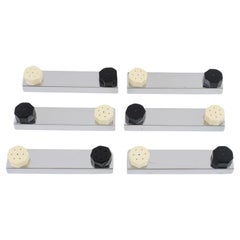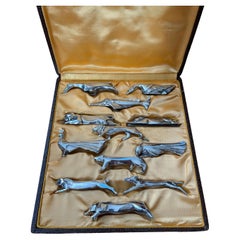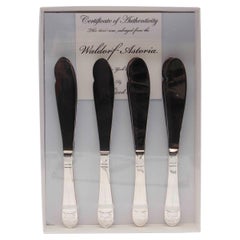Studio Art Deco-Lavina Tableware
to
1
1
1
1
1
1
1
1
1
1
1
1
1
1
19
315
296
281
217
Creator: Studio Art Deco-Lavina
Art Deco Chrome and Galalith Knife Rests Ensemble in Box
By Studio Art Deco
Located in Atlanta, GA
This French Art Deco knife rest or chopstick rest ensemble is still in its original box. The geometric shape features a chromed metal square stick shape with individual salt and pepp...
Category
1930s French Art Deco Vintage Studio Art Deco-Lavina Tableware
Materials
Metal, Chrome
Related Items
Set of 12 Fine French Art Deco Silver Plated "Gallia" Knife Rests by Christofle
By Marcel Eduoard Sandoz, Christofle
Located in Long Island City, NY
Set of 12 fine French Art Deco silver plated knife rests designed by Edouard-Marcel Sandoz for the Gallia collection of Christofle. All 12 animals are different.
Original case.
Aver...
Category
1930s French Art Deco Vintage Studio Art Deco-Lavina Tableware
Materials
Silver Plate
$3,800 / set
H 0.79 in W 3.94 in D 0.79 in
Unused Waldorf Astoria Hotel Art Deco 8 Fish Knife Set
By Oneida
Located in New York, NY
Sourced from the NYC Waldorf Astoria Hotel on Park Ave in NYC, NY. This set of 8 new old stock was stock on hand to be used as replacements if needed before the Hotel closed down. Silver plated steel with the famous Art...
Category
2010s American Art Deco Studio Art Deco-Lavina Tableware
Materials
Silver Plate, Steel
12 French Art Deco Dachshund Basset Hound Knife Rests, Rosé Glass, France, 1930s
Located in Vienna, AT
A set of 12 utterly charming 1930s Art Deco glass dog sculpture knife rests, featuring a delightful depiction of a dog, possibly a Basset Hound or a Dachshund / Sausage Dog / Wiener ...
Category
1930s Art Deco Vintage Studio Art Deco-Lavina Tableware
Materials
Glass
$1,200
H 1 in W 4 in D 1 in
Set of 12 Fine French Art Deco Silver Plated "Gallia" Knife Rests by Christofle
By Marcel Eduoard Sandoz, Christofle, Gallia
Located in Long Island City, NY
Set of 12 fine French Art Deco silver plated knife rests designed by Edouard-Marcel Sandoz for the Gallia collection of Christofle. All 12 animals are different.
Original case.
Aver...
Category
1930s French Art Deco Vintage Studio Art Deco-Lavina Tableware
Materials
Silver Plate
$3,800 / set
H 0.79 in W 3.94 in D 0.79 in
set of six Metal Animal Motif Knife Rests France 20th Century Art Deco
Located in Nuernberg, DE
A set of six beautiful figural flatware knife rests in the form of Animals and people, circa 1920s, France. Nice addition to every table or just for your collection. Tarnished and be...
Category
1920s Austrian Art Nouveau Vintage Studio Art Deco-Lavina Tableware
Materials
Metal
$320 / set
H 2 in W 3.13 in D 0.88 in
6 French Art Deco Dachshund Basset Hound Knife Rests, Light Blue Glass, 1930s
Located in Vienna, AT
A set of 6 utterly charming 1930s Art Deco glass dog rests for knives, featuring a delightful depiction of a dog—possibly a Basset Hound or a Dachshund / Sausage Dog / Wiener Dog. Cr...
Category
1930s Art Deco Vintage Studio Art Deco-Lavina Tableware
Materials
Glass
$600 / set
H 1 in W 4 in D 1 in
Art Nouveau set of 6 Knife Rests Poppy Flowers Gallia Christofle Silver Plated
By Gallia
Located in Paris, FR
This set of 6 knife-rests with blooming poppy flowers is a very good and typical Art Nouveau design. They are silver-plated, made by Gallia famous french silversmith part of Christofle world well-known. Each one is stamped and signed in the crossbar: "GALLIA METAL...
Category
Early 1900s French Art Nouveau Antique Studio Art Deco-Lavina Tableware
Materials
Silver Plate
$1,258 / set
H 1.38 in W 4.34 in D 1.58 in
Six Sweet Animal Knife Rests - by Etain Royal French vintage Metal Set in Box
Located in Nuernberg, DE
A lovely set of six knife rests. Made of pewter (etain) in France, the set is so pretty, consisting of 6 different animals in their slightly distressed original box. There are one ea...
Category
Mid-20th Century French Mid-Century Modern Studio Art Deco-Lavina Tableware
Materials
Metal
$220 / set
H 0.88 in W 2.75 in D 0.5 in
French Silver Shell Knife Rest, Set of 6
Located in Los Angeles, CA
Unique set of 6 vintage silver plate shell knife rests from France. Whimsical design and details. Delightful scallop shell motif at each end. Sold as a set of 6.
Category
Mid-20th Century French Studio Art Deco-Lavina Tableware
Materials
Metal, Silver Plate
Set of 12 Fine French Art Deco Silver plated "Gallia" Knife Rests by Christofle
By Marcel Eduoard Sandoz, Christofle
Located in Long Island City, NY
Set of 12 fine French Art Deco silver plated knife rests designed by Marcel Sandoz for the Gallia collection of Christofle. Six different animals are rep...
Category
1930s French Art Deco Vintage Studio Art Deco-Lavina Tableware
Materials
Silver Plate, Metal
$3,200 / set
H 0.79 in W 3.94 in D 0.79 in
Charming knife rests, opalescent opaline, Sabino art deco glass, 1920s, France
By Sabino Art Glass
Located in Wien, AT
Charming set of knife rests, made of high-quality opal glass, manufactured by the famous French glass manufacturer Sabino in the 1920s, in the Art Deco period.
The set consists of s...
Category
1920s French Art Deco Vintage Studio Art Deco-Lavina Tableware
Materials
Opaline Glass
$750 / set
H 3.94 in W 1.77 in D 1.1 in
Eight Art Deco Knife Rests in Clear Art Glass, France, 1930s / 40s
Located in København, Copenhagen
Eight Art Deco knife rests in clear art glass. France, 1930s / 40s.
Measures: 9 x 3 cm.
In excellent condition with micro shards.
Category
1930s French Art Deco Vintage Studio Art Deco-Lavina Tableware
Materials
Art Glass
$360 / set
H 1.19 in W 3.55 in D 1.19 in
Studio Art Deco-lavina tableware for sale on 1stDibs.
Studio Art Deco-Lavina tableware are available for sale on 1stDibs. These distinctive items are frequently made of wood and are designed with extraordinary care. Many of the original tableware by Studio Art Deco-Lavina were created in the Art Deco style in france during the 1930s. If you’re looking for additional options, many customers also consider tableware by Gallia, René Lalique, and Limoges. Prices for Studio Art Deco-Lavina tableware can differ depending upon size, time period and other attributes — on 1stDibs, these items begin at $850 and can go as high as $850, while a piece like these, on average, fetch $850.
Creators Similar to Studio Art Deco-Lavina
Questions About Studio Art Deco-Lavina Tableware
- What is an art deco watch?1 Answer1stDibs ExpertApril 5, 2022An art deco watch is defined by its geometric case, which is either circular or rectangular. The watch style was highly popular between 1920 and 1950, and is still sought after today. You’ll find a collection of art deco watches from some of the world’s top sellers on 1stDibs
- What is art deco jewelry?1 Answer1stDibs ExpertFebruary 22, 2021Art Deco jewelry was popular during the design movement of the 1920s and 30s. Art Deco jewelry is typically characterized by geometric patterns and gemstones of contrasting colors.
- What was the Art Deco movement?1 Answer1stDibs ExpertMay 30, 2024The Art Deco movement was a decorative style popular during the 1920s and ’30s. Few design styles are as universally recognized and appreciated as Art Deco. The term alone conjures visions of the Roaring Twenties, Machine Age metropolises, vast ocean liners, sleek typography and Prohibition-era hedonism. The iconic movement made an indelible mark on all fields of design, celebrating society's growing industrialization with refined elegance and stunning craftsmanship. Widely known designers associated with the Art Deco style include Émile-Jacques Ruhlmann, Eileen Gray, Maurice Dufrêne, Paul Follot and Jules Leleu. The term Art Deco derives from the name of a large decorative arts exhibition held in Paris in 1925. On 1stDibs, shop a wide range of Art Deco furniture and decorative objects.
- What is the history of Art Deco?1 Answer1stDibs ExpertMarch 25, 2024The history of Art Deco begins in the early 20th century.
Art Deco emerged as a global design style around the start of World War I, during the last years of Art Nouveau's popularity. The style conjures visions of the Roaring Twenties, Machine Age metropolises, vast ocean liners, sleek typography and Prohibition-era hedonism. Its hallmarks include the use of geometric designs influenced by Cubism. Major discoveries of Egyptian tombs during the era also influenced the movement.
The term Art Deco derives from the name of a large decorative arts exhibition, the Exposition Internationale des Arts Décoratifs et Industriels Modernes, held in Paris in 1925. After World War II, tastes shifted toward more functional, less ornate modernism, but today, the Art Deco style is still favored for its luxurious sophistication. On 1stDibs, shop a large selection of vintage Art Deco furniture. - What defines Art Deco?1 Answer1stDibs ExpertApril 5, 2024A few things define Art Deco. Date is one factor, as the style emerged in the 1920s and remained popular during the 1930s. Art Deco design usually includes bold geometric lines and forms or intricate repeating floral motifs. Designers working in this style tended to use expensive materials, such as shagreen or marble, as well as exotic woods like mahogany, ebony and zebra wood. Furniture often featured metal accents, mirrored finishes and embellishments made from exotic animal hides and inlays of mother-of-pearl or ivory. Shop a wide range of Art Deco furniture on 1stDibs.
- What is an Art Deco lamp?1 Answer1stDibs ExpertApril 5, 2022An Art Deco lamp is any lamp that’s made in the styles of the Art Deco movement, which was dominant in the 1920s and 1930s. On 1stDibs, you’ll find a collection of Art Deco lamps from some of the world’s top sellers.
- What is art deco ring?1 Answer1stDibs ExpertAugust 17, 2021Art Deco rings were made during the early 20th century. Named for a design movement that originated at a large decorative arts exhibition held in Paris in 1925, Art Deco rings are generally quite geometric, symmetrical and incorporate a variety of gemstones — especially sapphires and emeralds. Find a wide variety of Art Deco rings for sale on 1stDibs.
- When did Art Deco originate?1 Answer1stDibs ExpertFebruary 1, 2024The Art Deco period originated in France. Its name comes from the title of a large decorative arts exhibition held in Paris in 1925, credited with introducing the style to the world. It was informed by ancient Egypt, Cubism, Futurism, Louis XVI, De Stijl, modernism and the Vienna Secession and went on to influence the Streamline Moderne and mid-century modern movements. Shop a wide range of Art Deco furniture, decorative objects and jewelry on 1stDibs.
- What was Art Deco influenced by?1 Answer1stDibs ExpertMay 3, 2024Art Deco was influenced by a number of things. The discovery of ancient tombs around the turn of the century led to a renewed interest in Egyptian furniture and architecture that inspired Art Deco designers. Art Deco was also informed by Cubism, Futurism, Louis XVI style, De Stijl, modernism and the Vienna Secession. Shop a large collection of Art Deco furniture, decorative objects and jewelry on 1stDibs.
- How do I identify Art Deco?1 Answer1stDibs ExpertApril 5, 2022To identify Art Deco, look for the characteristics of the period. Furniture produced at the time is generally lacquered metal with a mirror-like glossy finish. Wooden items should be an exotic wood. Most items feature symmetrical designs, and geometric forms were popular motifs during the period. In addition, Art Deco often shows the influence of Hellenistic, Egyptian and Asian designs. Shop a variety of Art Deco furniture and decorative objects on 1stDibs.
- 1stDibs ExpertAugust 15, 2019
The main difference between Art Nouveau and Art Deco is that the former is detailed and ornate, and the latter is sharp and geometrical. When the movement started at the end of the 19th century, Art Nouveau was heavily influenced by nature and the curved lines of flowers. Art Deco, which became popular in the beginning of the 20th century, was inspired by the geometric abstraction of cubism.
- 1stDibs ExpertApril 5, 2022There are a few tell-tale signs you can look for to determine if a ring is from the Art Deco period. The first big sign is if it has a geometric element to it, as this was a big element of all Art Deco designs. Colored stones were also very popular in the period and it’s not uncommon to see sapphires or rubies taking center stage, rather than a diamond. During the Art Deco period, yellow gold was not very common, instead, jewelers crafted pieces of white gold or platinum. Shop a collection of authentic Art Deco jewelry from some of the world’s top boutiques on 1stDibs.
- 1stDibs ExpertMarch 31, 2023The simplest way to make an Art Deco bedroom is to purchase authentic furniture and decorative accents from the 1920s and ‘30s. Top designers from the period include Émile-Jacques Ruhlmann, Eileen Gray, Maurice Dufrêne and Jules Leleu. Pair authentic Art Deco pieces with a bedding set in a colorful, intricate floral print, or dress up the walls with wallpaper in a geometric motif with hints of gold. The iconic Art Deco movement made an indelible mark on all fields of design throughout the 1920s and ’30s, celebrating society’s growing industrialization with refined elegance and stunning craftsmanship. Find a selection of Art Deco furniture and decor from some of the world's top sellers on 1stDibs.
- What era was Art Deco rings?1 Answer1stDibs ExpertJune 30, 2023Art Deco rings are from the era of the 1920s and 1930s. While Art Deco began to emerge a bit earlier than that, the style truly gained momentum after the end of World War I. Rings from the time period often feature geometric motifs, bold colors and designs that were influenced by Cubism, Futurism and other movements in visual art. Diamonds were exceptionally popular, while accent gems such as sapphires, emeralds and rubies brought vivid color to engagement rings and added sophistication and glamour. On 1stDibs, shop a variety of Art Deco rings.
- What is Art Deco’s time period?1 Answer1stDibs ExpertSeptember 25, 2019
The Art Deco era is 1925 to 1940.
- What does Art Deco ring mean?1 Answer1stDibs ExpertFebruary 17, 2023The term Art Deco ring means a ring produced in the Art Deco style. Most Art Deco jewelry dates back to the 1920s and 30s and features defined lines and geometric motifs. While a lot of Art Deco rings were black and white — the black coming from the use of onyx or black enamel and the white from rock crystal and diamonds — there is plenty of color in jewelry of the era. A perfect accent to diamonds in platinum settings were blue sapphires, emeralds and rubies, and these stones were also used in combination with each other. On 1stDibs, find a variety of Art Deco rings.
- 1stDibs ExpertMay 30, 2024There are many famous Art Deco artists. In addition, the movement produced many well-known designers and architects. Some of the most notable creatives who contributed to the Art Deco movement include Émile-Jacques Ruhlmann, René Lalique, Eileen Gray, Jean Dunand, Donald Deskey and Jean Perzel. Explore a wide range of Art Deco furniture and decorative objects on 1stDibs.
- 1stDibs ExpertSeptember 25, 2019
Art Deco is characterized by geometric shapes, bold colors, visual drama and metallic finishes.
- 1stDibs ExpertFebruary 27, 2024In its time, Art Deco went out of style due to shifts in trends. After World War II, designers became more interested in modernism and creating pieces with an emphasis on function and simplicity, a move away from the embellishment and adornment that characterized the Art Deco style. It's important to note that Art Deco never fully disappeared. In fact, many present-day collectors have a passion for pieces produced during the 1920s and ’30s. Shop a large selection of Art Deco furniture on 1stDibs.
- 1stDibs ExpertAugust 26, 2024The difference between Memphis and Art Deco is that the terms refer to two different design styles. Art Deco emerged in the 1920s, and its pieces often flaunt bold geometric lines and forms, floral motifs and ornamental details, such as mirrored finishes and inlays of mother-of-pearl or ivory. Named after the Memphis Group, which formed in 1980, Memphis design emphasizes freedom of expression, dizzying patterns and off-the-wall colors. Some people describe it as Art Deco meets Pop art. On 1stDibs, find a collection of Art Deco and Memphis design furniture.
Recently Viewed
View AllMore Studio Art Deco-Lavina Furniture
Studio Art Deco-Lavina Centerpieces
Studio Art Deco-Lavina Decorative Objects
Studio Art Deco-Lavina Building and Garden Elements
Studio Art Deco-Lavina Tables
Studio Art Deco-Lavina Decorative Boxes
Studio Art Deco-Lavina Desk Sets
Studio Art Deco-Lavina Bookends
Studio Art Deco-Lavina Cigar Boxes and Humidors
Studio Art Deco-Lavina Candlesticks
Studio Art Deco-Lavina Wall Clocks
Studio Art Deco-Lavina Coat Racks and Stands
Studio Art Deco-Lavina Umbrella Stands


